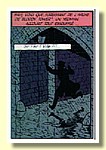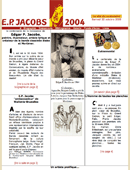 Il numero dei saggi comparsi negli ultimi anni su E.P. Jacobs e la serie Blake e Mortimer potrebbe indurre a pensare che sull’argomento sia ormai stato detto tutto quello che si poteva dire, eppure non è affatto così. Alcuni di questi saggi sono poco più di un pretesto per pubblicare qualche immagine inedita e per confezionare un prodotto accattivante che, pur non avendo molto da dire, non mancherà di attirare all’acquisto i numerosi fan incondizionati di questo autore. Non è questo il caso di Renaud Chavanne e del suo saggio. Qui non ci sono concessioni estetiche per la gioia del lettore / collezionista di qualunque cosa nuova o presunta tale su Jacobs. Le poche illustrazioni contenute nel libro sono in bianco e nero e di qualità abbastanza scadente, ma sono funzionali a chiarire gli intenti del testo. Si tratta di un saggio di livello accademico (tipo quelli di Pierre Fresnault-Deruelle o di Thierry Groensteen, per intenderci) che ha il grande merito di dire qualcosa di nuovo e di utile, e di farlo in modo scientifico. Chavanne si occupa qui della composizione jacobsiana a livello di striscia e di tavola. In particolare analizza il processo di frammentazione di cui sarà oggetto la striscia jacobsiana durante l’evoluzione della prima storia di Blake e Mortimer (ma tenendo presente anche Le Rayon U). Questo processo di frammentazione ha origine, secondo Chavanne, dalla creazione di alcuni modelli di striscia tipici di Jacobs (ad esempio
Il numero dei saggi comparsi negli ultimi anni su E.P. Jacobs e la serie Blake e Mortimer potrebbe indurre a pensare che sull’argomento sia ormai stato detto tutto quello che si poteva dire, eppure non è affatto così. Alcuni di questi saggi sono poco più di un pretesto per pubblicare qualche immagine inedita e per confezionare un prodotto accattivante che, pur non avendo molto da dire, non mancherà di attirare all’acquisto i numerosi fan incondizionati di questo autore. Non è questo il caso di Renaud Chavanne e del suo saggio. Qui non ci sono concessioni estetiche per la gioia del lettore / collezionista di qualunque cosa nuova o presunta tale su Jacobs. Le poche illustrazioni contenute nel libro sono in bianco e nero e di qualità abbastanza scadente, ma sono funzionali a chiarire gli intenti del testo. Si tratta di un saggio di livello accademico (tipo quelli di Pierre Fresnault-Deruelle o di Thierry Groensteen, per intenderci) che ha il grande merito di dire qualcosa di nuovo e di utile, e di farlo in modo scientifico. Chavanne si occupa qui della composizione jacobsiana a livello di striscia e di tavola. In particolare analizza il processo di frammentazione di cui sarà oggetto la striscia jacobsiana durante l’evoluzione della prima storia di Blake e Mortimer (ma tenendo presente anche Le Rayon U). Questo processo di frammentazione ha origine, secondo Chavanne, dalla creazione di alcuni modelli di striscia tipici di Jacobs (ad esempio  quelli che Chavanne definisce 1/2/1, o 2/1/2), e porterà col tempo a un numero sempre crescente di vignette nella tavola. Verso la fine di Le Secret de l’Espadon Jacobs arriverà a quella che Chavanne definisce ‘l’Esplosione’: una tavola (p. 53 del terzo volume) che costituisce un tutto unico e in cui la striscia è di fatto scomparsa. Questa esplosione è in realtà legata alla struttura narrativa, e riflette il crollo dell’impero tibetano di Basam Damdu e il ritorno all’ordine. Nella tavola, questo ritorno all’ordine si traduce in un ritorno alla costruzione della tavola in strisce, che caratterizzerà poi tutte le avventure successive. Tuttavia non si tratterà più di
quelli che Chavanne definisce 1/2/1, o 2/1/2), e porterà col tempo a un numero sempre crescente di vignette nella tavola. Verso la fine di Le Secret de l’Espadon Jacobs arriverà a quella che Chavanne definisce ‘l’Esplosione’: una tavola (p. 53 del terzo volume) che costituisce un tutto unico e in cui la striscia è di fatto scomparsa. Questa esplosione è in realtà legata alla struttura narrativa, e riflette il crollo dell’impero tibetano di Basam Damdu e il ritorno all’ordine. Nella tavola, questo ritorno all’ordine si traduce in un ritorno alla costruzione della tavola in strisce, che caratterizzerà poi tutte le avventure successive. Tuttavia non si tratterà più di  strisce equilibrate, come quelle dell’Espadon, ma bensì asimmetriche. Una delle principali preoccupazioni di Chavanne è proprio di dimostrare come le storie di Jacobs si basino sempre sulla striscia e non sulla tavola, contestando con ciò la tesi di Benoît Peeters (Leggere il fumetto, Vittorio Pavesio Productions, Torino 2000, pp. 41-48) che vede nella tavola jacobsiana un utilizzo spesso decorativo. Si può essere più o meno d’accordo con l’autore (personalmente, pur riconoscendo la funzione fondamentale della striscia nella composizione jacobsiana, vedo anche una costante attenzione per l’estetica e
strisce equilibrate, come quelle dell’Espadon, ma bensì asimmetriche. Una delle principali preoccupazioni di Chavanne è proprio di dimostrare come le storie di Jacobs si basino sempre sulla striscia e non sulla tavola, contestando con ciò la tesi di Benoît Peeters (Leggere il fumetto, Vittorio Pavesio Productions, Torino 2000, pp. 41-48) che vede nella tavola jacobsiana un utilizzo spesso decorativo. Si può essere più o meno d’accordo con l’autore (personalmente, pur riconoscendo la funzione fondamentale della striscia nella composizione jacobsiana, vedo anche una costante attenzione per l’estetica e  l’equilibrio della tavola, o anche della doppia tavola, nel suo complesso), ma la sua analisi è seria e documentata. Per questo sono molto utili (e talvolta sorprendenti) i numerosi grafici con cui l’autore sostiene la sua tesi. Se una pecca si può trovare in questo lavoro, è la forse eccessiva insistenza dell’analisi sulla prima storia del ciclo, a scapito di quelle successive che sono sicuramente più importanti (anche se chiaramente meno significative per Chavanne).
l’equilibrio della tavola, o anche della doppia tavola, nel suo complesso), ma la sua analisi è seria e documentata. Per questo sono molto utili (e talvolta sorprendenti) i numerosi grafici con cui l’autore sostiene la sua tesi. Se una pecca si può trovare in questo lavoro, è la forse eccessiva insistenza dell’analisi sulla prima storia del ciclo, a scapito di quelle successive che sono sicuramente più importanti (anche se chiaramente meno significative per Chavanne).  È difficile condividere la tesi dell’autore secondo cui l’asimmetria crescente delle avventure di Blake e Mortimer si accompagna a un indebolimento delle stesse, facendo perdere a Jacobs la genialità peculiare delle prime opere e rendendolo un autore come tanti altri. Non si spiegherebbe in tal modo come mai i capolavori di Jacobs cadano tutti nel periodo ‘asimmetrico’(cioè dalla Grande Pyramide in avanti). Con ciò non si intende certo sminuire il lavoro di Chavanne, che è destinato a rimanere uno degli studi fondamentali su Jacobs. Trattandosi di un piccolo editore, la reperibilità è difficile, e il prezzo relativamente alto. R. Chavanne, Edgar P. Jacobs & le Secret de l’Explosion, PLG, Montrouge 2005, pp. 301, € 29. Info: www.lexplosion.net [Guido Vogliotti]
È difficile condividere la tesi dell’autore secondo cui l’asimmetria crescente delle avventure di Blake e Mortimer si accompagna a un indebolimento delle stesse, facendo perdere a Jacobs la genialità peculiare delle prime opere e rendendolo un autore come tanti altri. Non si spiegherebbe in tal modo come mai i capolavori di Jacobs cadano tutti nel periodo ‘asimmetrico’(cioè dalla Grande Pyramide in avanti). Con ciò non si intende certo sminuire il lavoro di Chavanne, che è destinato a rimanere uno degli studi fondamentali su Jacobs. Trattandosi di un piccolo editore, la reperibilità è difficile, e il prezzo relativamente alto. R. Chavanne, Edgar P. Jacobs & le Secret de l’Explosion, PLG, Montrouge 2005, pp. 301, € 29. Info: www.lexplosion.net [Guido Vogliotti]
 The number of books published in recent years on E.P. Jacobs and his series Blake and Mortimer might lead us to believe that everything has now been said and written, but this is clearly not the case. Some of these books were in fact little more than a pretext for disclosing some previously unpublished illustration, making a rather empty but attractive product that none of the Jacobs fans would not want to buy. This is not the case with Renaud Chavanne and his book. There are no aesthetic concessions here for the joy of the reader / collector craving for anything new or supposedly new on Jacobs: the few illustrations are in black and white, and the quality is far from excellent, but they are functional to the text and the book is packed with information. This is in fact an academic-level essay (in line with what we are used to see from P. Fresnault-Deruelle or Thierry Groensteen), with the great merit of saying something new, and of doing it in a scientific manner. Chavanne sets out to study the composition in Jacobs, looking at strips and plates. Notably he analyses the process of fragmentation the strip will undergo in the course of Jacobs’ first story, The Secret of the Swordfish (but with an eye on The U Ray as well). This process of fragmentation originates,
The number of books published in recent years on E.P. Jacobs and his series Blake and Mortimer might lead us to believe that everything has now been said and written, but this is clearly not the case. Some of these books were in fact little more than a pretext for disclosing some previously unpublished illustration, making a rather empty but attractive product that none of the Jacobs fans would not want to buy. This is not the case with Renaud Chavanne and his book. There are no aesthetic concessions here for the joy of the reader / collector craving for anything new or supposedly new on Jacobs: the few illustrations are in black and white, and the quality is far from excellent, but they are functional to the text and the book is packed with information. This is in fact an academic-level essay (in line with what we are used to see from P. Fresnault-Deruelle or Thierry Groensteen), with the great merit of saying something new, and of doing it in a scientific manner. Chavanne sets out to study the composition in Jacobs, looking at strips and plates. Notably he analyses the process of fragmentation the strip will undergo in the course of Jacobs’ first story, The Secret of the Swordfish (but with an eye on The U Ray as well). This process of fragmentation originates,  Chavanne believes, from the creation of some peculiar strip models typical of Jacobs (for instance what he calls 1/2/1, shown on the book cover, or 2/1/2) and in time it will lead to an increasing number of cases in the page. Towards the end of The Secret of the Swordfish, Jacobs will come to what Chavanne refers to as the ‘Explosion’: a plate (p. 53 of the 3rd volume) which is a single unit, and where the strip has disintegrated. This explosion is in reality linked to the narrative structure, and reflects the fall of Basam Damdu’s Tibetan empire and the return to order. For Jacobs, this return to order means a return to an ordinary page made of strips, which will remain the basis for all the following stories. But these strips will no longer be balanced like those of The Secret of the Swordfish, they will be asymmetrical. One of Chavanne’s main concerns is indeed to show how the strip (as opposed to the page) will always remain the fundamental unit in Jacobs’ composition, thus disagreeing with Benoît Peeters’ contention (Case, planche, récit, Casterman 1991, pp 40-47) that Jacobs often makes a decorative use of the plate. One can agree or disagree with the author (I personally recognise the fundamental function of the strip in Jacobs, but I also see a constant attention to the aesthetics and balance of the page, or even double page, as a whole) but his analysis is serious and well-documented and he relies on a number of useful and at times surprising graphs. Possibly Chavanne insists too much on The Secret of the Swordfish, leaving little space for later stories that are no doubt more important (even though clearly less significant for him). It is difficult to accept the author’s view that the increasing asymmetry in Blake and Mortimer’s adventures is accompanied by a weakening structure, and that in this way Jacobs loses his genius and becomes an author like many others. How do we then explain that Jacobs’ major stories (from The Mystery of the Great Pyramid onwards) all fall into this ‘asymmetrical’ period? This should in no way belittle Chavanne’s work, which will remain a standard reference on Jacobs. PLG being a small publisher the book may not be easy to find, and the price is relatively high. R. Chavanne, Edgar P. Jacobs & le Secret de l’Explosion, PLG, Montrouge 2005, pp. 301, € 29. Info: www.lexplosion.net [Guido Vogliotti]
Chavanne believes, from the creation of some peculiar strip models typical of Jacobs (for instance what he calls 1/2/1, shown on the book cover, or 2/1/2) and in time it will lead to an increasing number of cases in the page. Towards the end of The Secret of the Swordfish, Jacobs will come to what Chavanne refers to as the ‘Explosion’: a plate (p. 53 of the 3rd volume) which is a single unit, and where the strip has disintegrated. This explosion is in reality linked to the narrative structure, and reflects the fall of Basam Damdu’s Tibetan empire and the return to order. For Jacobs, this return to order means a return to an ordinary page made of strips, which will remain the basis for all the following stories. But these strips will no longer be balanced like those of The Secret of the Swordfish, they will be asymmetrical. One of Chavanne’s main concerns is indeed to show how the strip (as opposed to the page) will always remain the fundamental unit in Jacobs’ composition, thus disagreeing with Benoît Peeters’ contention (Case, planche, récit, Casterman 1991, pp 40-47) that Jacobs often makes a decorative use of the plate. One can agree or disagree with the author (I personally recognise the fundamental function of the strip in Jacobs, but I also see a constant attention to the aesthetics and balance of the page, or even double page, as a whole) but his analysis is serious and well-documented and he relies on a number of useful and at times surprising graphs. Possibly Chavanne insists too much on The Secret of the Swordfish, leaving little space for later stories that are no doubt more important (even though clearly less significant for him). It is difficult to accept the author’s view that the increasing asymmetry in Blake and Mortimer’s adventures is accompanied by a weakening structure, and that in this way Jacobs loses his genius and becomes an author like many others. How do we then explain that Jacobs’ major stories (from The Mystery of the Great Pyramid onwards) all fall into this ‘asymmetrical’ period? This should in no way belittle Chavanne’s work, which will remain a standard reference on Jacobs. PLG being a small publisher the book may not be easy to find, and the price is relatively high. R. Chavanne, Edgar P. Jacobs & le Secret de l’Explosion, PLG, Montrouge 2005, pp. 301, € 29. Info: www.lexplosion.net [Guido Vogliotti]Articolo di afnews (se non altrimenti indicato) - Lunedì, 3/4/2006
© copyright afNews/Goria/Autore - https://www.afnews.info ISSN 1971-1824 - cod-Recensioni
 Andate su www.afnews.info per leggere le altre notizie, vedere altre immagini, altri video e disegni, accedere agli archivi, ai servizi ecc. e fruire di tutte le novità che si trovano nella homepage di afNews.
Andate su www.afnews.info per leggere le altre notizie, vedere altre immagini, altri video e disegni, accedere agli archivi, ai servizi ecc. e fruire di tutte le novità che si trovano nella homepage di afNews. Volete ricevere queste notizie via eMail, come Newsletter gratuita? Fate click qui! Quindi compilate il semplicissimo modulo: 1- inserite il vostro indirizzo eMail al quale volete ricevere la newsletter, 2- inserite il codice di controllo che trovate nel modulo - la consueta serie di lettere antispam, 3- fate click su "Complete Subscription Request" e 4- ricordate di rispondere al messaggio di verifica che FeedBurner vi invierà per posta elettronica. Se non rispondete al messaggio di verifica, l'abbonamento alla newsletter non verrà attivato: quindi... occhio!
Volete ricevere queste notizie via eMail, come Newsletter gratuita? Fate click qui! Quindi compilate il semplicissimo modulo: 1- inserite il vostro indirizzo eMail al quale volete ricevere la newsletter, 2- inserite il codice di controllo che trovate nel modulo - la consueta serie di lettere antispam, 3- fate click su "Complete Subscription Request" e 4- ricordate di rispondere al messaggio di verifica che FeedBurner vi invierà per posta elettronica. Se non rispondete al messaggio di verifica, l'abbonamento alla newsletter non verrà attivato: quindi... occhio!
Oppure, per ricevere le notizie in vari altri modi, fate click qui per sapere come fare. Se volete inserire le afNews in un vostro sito o blog, tramite gadget, widget, RSS-XML ecc., fate click qui per sapere come fare.
Se volete inserire le afNews in un vostro sito o blog, tramite gadget, widget, RSS-XML ecc., fate click qui per sapere come fare.
